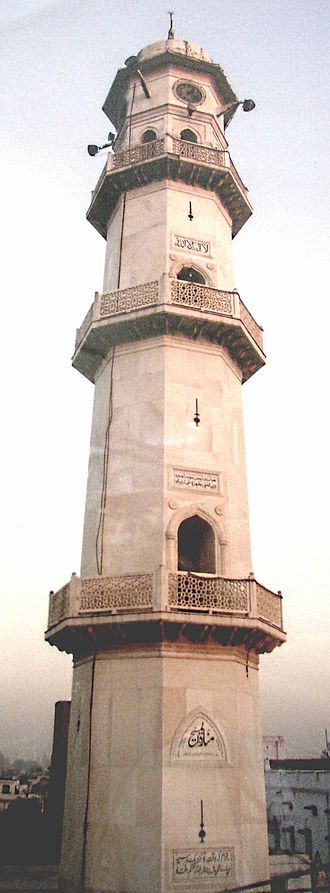The White Minaret (Urdu: Minarat-ul Masih, English: Minaret of the Messiah) is a tower and monument standing beside the Mubarak Mosque in Qadian, Punjab, India. The foundation stone for the minaret was laid by Mirza Ghulam Ahmad, the founder of the Ahmadiyya movement on 13 March 1903. Due to a lack of funds, construction subsequently stopped. Work continued under Mirza Basheer-ud-Din Mahmood Ahmad the second Khalifa on 27 November 1914, reaching completion in 1916. The minaret has three stages, 92 steps, and a total height of about 105 feet. The Minarat-ul Masih is classified as a historical monument
On 28 May 1900, Mirza Ghulam Ahmad claimed to have received the revelation:
Step forth that your time has Arrived and the feet of the people of Muhammad have been firmly planted on a high tower.
— Mirza Ghulam Ahmad, Tadhkirah, pg.
Ghulam Ahmad then solicited donations for the building of the minaret to commemorate the following hadith by the Islamic prophet Muhammad regarding the second coming of Jesus:
Allah would send Christ, son of Mary, and he will descend with the white minaret, east of Damascus, wearing two garments lightly dyed with saffron and placing his hands on the wings of two Angels.
— Sahih Muslim Book 41, Hadith 7015
An associated advertisement argued that construction of the minaret would fulfill the prophecy:
Our village of Qadian and this our mosque near which a Minaret will be constructed, is situated to the east of Damascus.
— Minaretul Maseeh dated 28th May 1900, Majmooa Ishtiharat
This Minaret is that minaret whose need has been accepted in Holy Prophet's Hadiths. — Majmooa Ishtiharat
According to Ghulam Ahmad, the affiliation of the descent of Jesus with a 'white minaret' symbolized the spread of the 'light of Islam'. He stated that it symbolized the beginning of a new age for humanity, the revival and supremacy of Islam, and embodied both the physical and spiritual aspects of Islam. It was believed to have been a signifier of a coming age of enlightenment where new facilities for communication and transport would make conveyance and proselytizing easier. It now stands as an emblem of Ahmadiyya Islam, with the light and clock affixed at its top symbolizing the spread of the teachings of Islam and reminder of man's place in time.










